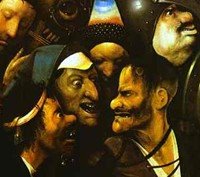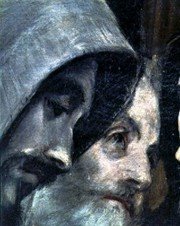| PAINTING The art of painting consists of the arrangement of shapes, lines, colours, tones and textures on a two-dimensional surface, thus creating an aesthetic image. More than that one cannot say, the sheer variety of possibilities precludes any more precise definition. The finished painting may be whollyrepresentational and naturalistic - such as those of the photorealists (eg. Richard Estes) - or wholly abstract - comprising only geometric shapes (like those by Piet Mondrian, or Bridget Riley) - or anywhere in between. In genre terms, it might be a narrative history work, a portrait, a genre-scene, a landscape or a still life. It may be painted using encaustic, tempera or fresco paint, oils, acrylics or watercolours, or any of the new contemporary mediums. And as art critics and historians can testify, there are countless conflicting theories about the function, design, style-hierarchy and aesthetics of painting, so perhaps the safest thing is to say that as "visual artists", painters are engaged in the task of creating two-dimensional works of visual expression, in whatever manner appeals to them. |
ART OF PAINTING | Painting Composition and Design Sometimes called "disegno" - a term derived from Renaissance art which translates as both design and drawing, thus including the artist's idea of what he wants to create as well as its execution - painting design concerns theformal organization of various elements into a coherent whole. These formal elements include: Line, Shape/Mass, Colour, Volume/ Space,Time/Movement. (1) Line encompasses everything from basic outlines and contours, to edges of tone and colour. Linework fixes the relationship between adjacent or remote elements and areas of the painting surface, and their relative activity or passivity. (2) Shape and Mass includes the various different areas of colour, tone and texture, together with any specific images therein. Many of the most famous paintings (eg. "The Last Supper" by Leonardo Da Vinci) are optically arranged around geometric shapes (or a mixture thereof). Negative space can also be used to emphasise certain features of the composition. (3) Not surprisingly, given that the human eye can identify up to 10 million differing hues, colour has many different uses. It can be used in a purely descriptive manner - Egyptians used different colours to distinguish Gods or Pharaohs, and to differentiate men from women - or to convey moral messages or emotional moods, or enhance perspective (fainter colours for distant backgrounds). Above all, colour is used to depict the effects of light (see the series of "Haystacks" or "Rouen Cathedral" by Claude Monet), while many great painters like Caravaggio and Rembrandt have exploited the contrast between colours for dramatic effect - notably in the technique of chiaroscuro (see Rembrandt's "The Night Watch"). See colour in painting. |
(4) The elements of Volume and Space are concerned with how the painter creates depth and spatial relationships within the flat surface of the picture. Traditional painters do this by deploying the concept of linear perspective, as developed by Florentine Renaissance masters like Piero della Francesca, while others, such as Paul Cezanne and the Cubists Picasso, Braque and Marcel Duchamp, expressed space and volume by showing a range of overlapping "snapshots" of the same object as if viewed simultaneously from different viewpoints. Still others, like naive (naif) or primitive-style painters show objects not in their true-life naturalistic relationship to each other, but separately, from whatever angle best shows their characteristic features - this includes the flattened stylistic forms used, for instance, by the Egyptians. (5) The elements of Time and Movement concern how the viewer's eye is allowed to experience the picture, in terms of speed and direction, both for its narrative development (eg. in large-scale history murals), or its angular opportunities for study (eg. Cubist paintings depicting several "snapshots" of the same objects). Painting Interpretation In addition to creating a visual object, an artist also aims to infuse it with a degree of intellectual content, in the form of symbolism, a moral or social message, or some other meaningful content. Thus, the famous American critic Clement Greenberg (1909-94) once stated that all great art should aim to create tension between visual appeal and interpretive possibility. The history of art is full of examples of interpretive content. For example, Egyptian art is noted for its iconographic imagery, as are Byzantine panel paintings and pre-Renaissance frescos. Renaissance pictures, such as those by Old Masterssuch as Botticelli, Leonardo and Raphael , often took the form of highly complex allegorical works, a tradition that was maintained throughout the succeeding Baroque and Neoclassical eras of the 17th and 18th centuries. Even still lifes, notably the Vanitas genre, were infused with moralistic allegory. However, the tradition waned somewhat during the 19th century, under the dominant influences of Romanticism, Impressionism and to a lesser extent Expressionism, before reemerging in the 20th century, when Cubism and Surrealism exploited it to the full. Mediums of Painting Encaustic One of the main painting mediums of the ancient world, encaustic paintingemploys hot beeswax as a binding medium to hold coloured pigments and to enable their application to a surface - usually wood panels or walls. It was widely used in Egyptian, Greek, Roman and Byzantine art. Fresco Fresco (Italian for "fresh") refers to the method of painting in which pigments are mixed solely with water (no binding agent used) and then applied directly onto freshly laid plaster ground, usually on a plastered wall or ceiling. The plaster absorbs the liquid paint and as it dries, retaining the pigments in the wall. Extra effects were obtained by scratching techniques like sgraffito. The greatest examples of fresco painting are probably Michelangelo's "Genesis" and "Last Judgment" murals in the Sistine Chapel, in Rome. Tempera Instead of beeswax, the painting medium tempera employs an emulsion of water and egg yolk (occasionally mixed with glue, honey or milk) to bind the pigments. Tempera painting was eventually superceded by oils, although as a method for painting on panels it endured for centuries. |
Oils The dominant medium since 1500, oil painting uses oils like linseed, walnut, or poppyseed, as both a binder and drying agent. Its popularity stems from the increased richness and glow that oil gives to the colour pigments. It also facilitated subtle details, using techniques like sfumato, as well as bold paintwork obtained through thick layering (impasto). Important pioneers of oil paint techniques included (in Holland) Hubert and Jan Van Eyck, and (in Italy) Piero della Francesca, Filippo Lippi, Antonello da Messina, and Leonardo Da Vinci. Watercolours and Gouache Watercolour painting - a rather unforgiving medium - developed in England during the 18th/19th century - uses water soluble pigments pre-formulated with a binder, typically gum arabic. When watercolours are thickened, made opaque and mixed with white, it is called gouache. Early pioneers of watercolour painting include Thomas Girtin and JMW Turner. Acrylics The most modern of all mediums, acrylic painting is a man-made paint containing a resin derived from acrylic acid that combines some of the properties of watercolour and oils. Highly versatile, it can be applied to almost any surface in varying amounts, ranging from thin washes to thick impastoed layers. It can give either a matt or gloss finish and is extremely fast-drying. Popular with many famous artists, including David Hockney, acrylic painting may yet supercede oils during the 21st century. Forms of Painting Murals Dating back to Paleolithic cave painting, murals were painted in tombs, temples, sanctuaries and catacombs throughout the ancient Western world, including Etruria, Egypt, Crete, and Greece. Initially devoid of "depth", they were fully developed during early Renaissance times by fresco artists like Giotto, and later by Masaccio, Fra Angelico, Raphael and Michelangelo. As interior decoration became increasingly dominated by stained glass and tapestry, mural painting declined, although a number of site-specific works were commissioned during the 19th and 20th centuries. Panel Painting The earliest form of portable painting, panels were widely used (eg) in Egyptian and Greek art (although only a few have survived), and later by Byzantine artists from 400 CE onwards. As with murals, panel-paintings were rejuvenated during the late Gothic and early Renaissance period, chiefly as a type of decorative devotional art - eg. "The Ghent Altarpiece" (1432) by the Van Eycks, and "The Deposition" (1440) by Roger van der Weyden. Wooden panel painting was especially popular in Northern Europe, due to the climate which was not favourable for fresco murals, and remained so up until the end of the 17th century. Easel Painting This form, like panel painting, was a form of studio art but used canvas as a support rather than wood panels. Canvas was both lighter and less expensive than panels, and required no special priming with gesso and other materials. From the Baroque era onwards (1600) oil on canvas became the preferred form of painting throughout Europe. It was particularly popular with the new bourgeois patrons of art (eg. portraiture) for home display. |
| Manuscript Illumination Dating back to celebrated examples from ancient Egypt, like the "Book of the Dead", this type of painting achieved its apogee during the Middle Ages (c.500-1000 CE) in the form of Carolingian and Irish illuminated manuscripts, (eg. Gospel texts like Book of Kells, Lindisfarne Gospels, Book of Durrow). Typically executed in egg-white tempera on vellum and card, these painted manuscripts featured extremely rich and complex graphic designs of Celtic-style interlace, knotwork, spirals and zoomorphs, as well as figurative portraits of Saints and Apostles. Sadly, the advent of the printing press in 15th century Germany put this art form out of business in Europe. Thereafter it survived only in the East, notably in the form of Islamic calligraphic painting and decorated texts, and miniatures from India. Scroll Painting Hand scrolls are an East Asian art form dating from c.350 CE, common to both China and Japan. Composed of varying lengths of paper or silk, they featured a wide variety of ink and wash paintings whose subjects included landscapes, Buddhist themes, historical or mythological scenes, among others. Screen/Fan Painting There are two basic types of painted screen: traditional Chinese and Japanese folding screens, painted in ink or gouache on paper or silk, dating from the 12th century - a form which later included lacquer screens; and the iconostasis screen, found in Byzantine, Greek and Russian Orthodox churches, which separates the sanctuary from the nave. This screen is traditionally decorated with religious icons and other imagery, using either encaustic or tempera paints. Painted fans - typically decorated with ink and coloured pigments on paper, card or silk, sometimes laid with gold or silver leaf - originated in China and Japan, although curiously many were actually painted in India. In Europe, fan painting was not practised until the 17th century, and only properly developed in France and Italy from about 1750 onwards. Modern Forms of Painting 20th Century painters have experimented with a huge range of supports and materials, including steel, concrete, polyester, neon lights, as well as an endless variety of "found" objects (objets trouves). The latter is exemplified in the works of Yves Klein (1928-62), who decorated women's nude bodies with blue paint and then imprinted them on canvas; and Robert Rauschenberg(1925-2008) whose work "Bed" (1955) consisted of the quilt from his own bed, painted with toothpaste, lipstick and fingernail polish. Painting Genres There are five traditional painting genres. These are ranked as follows: |



No comments:
Post a Comment